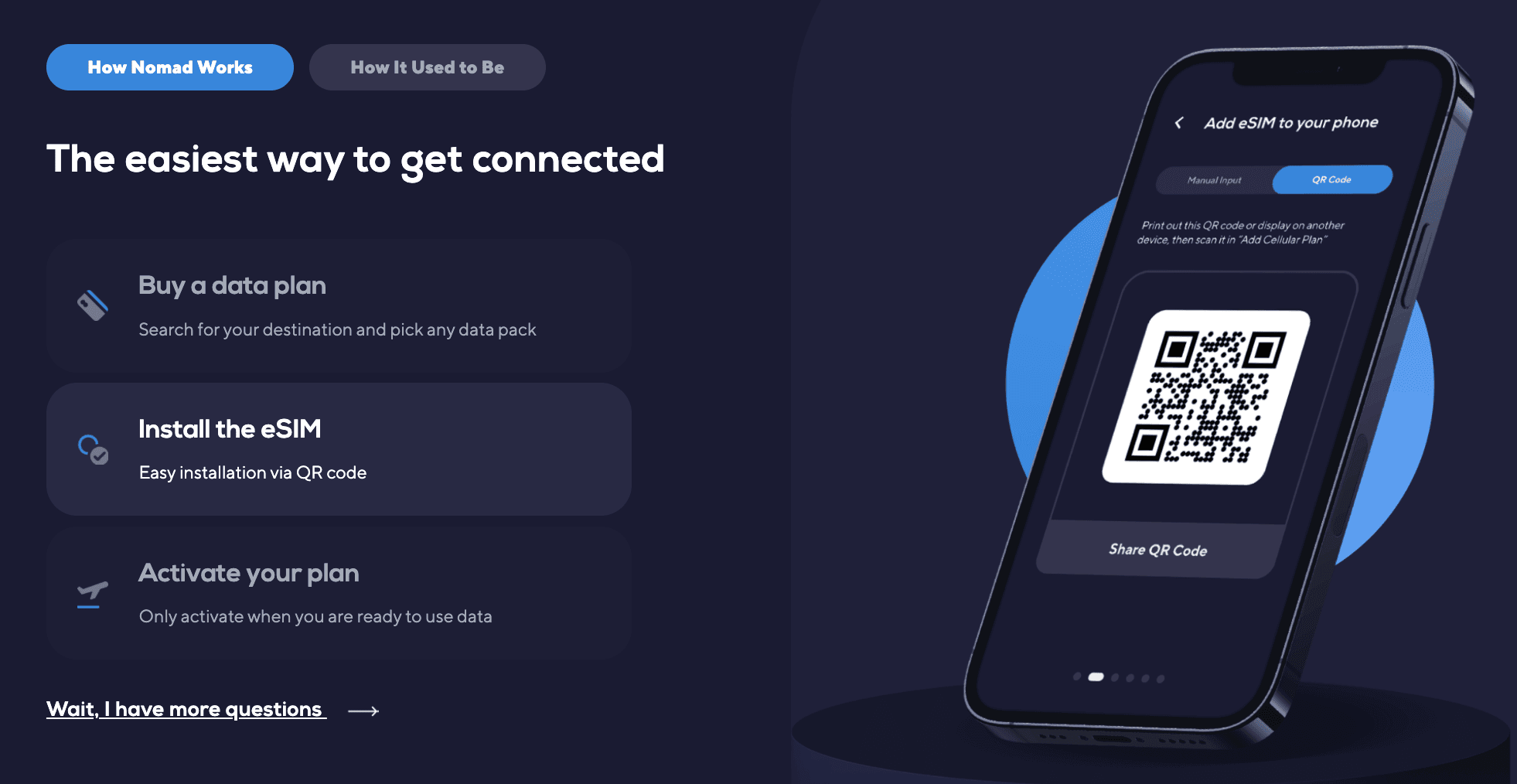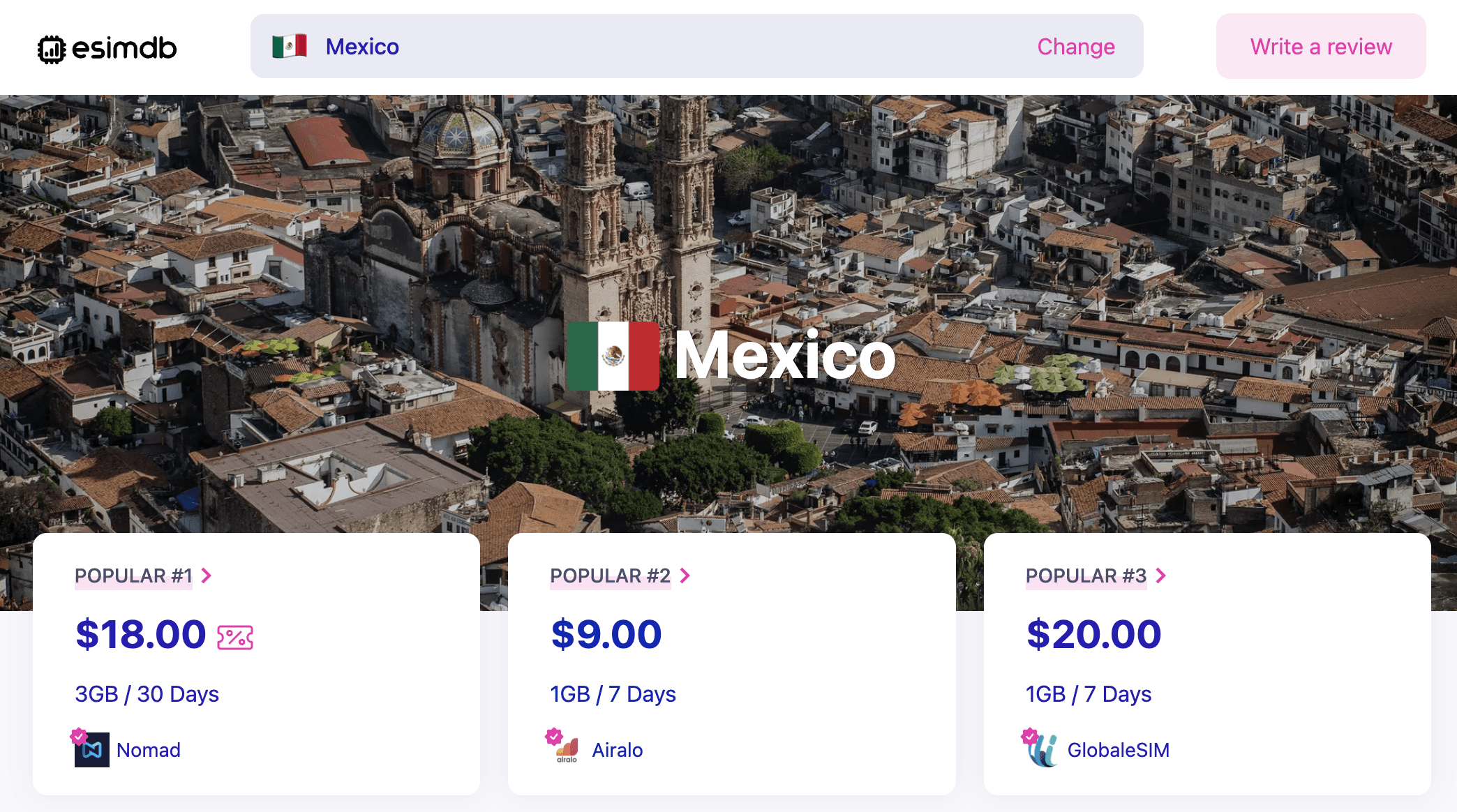eSIM
Einführung in eSIMs: Was ist eSIM
Eine datengestützte Entlarvung der fünf häufigsten eSIM-Mythen
eSIMist die Abkürzung füreingebettete SIM, und ist wie eine digitale Version einer SIM-Karte, die in Ihr Gerät eingebettet ist. Sie können damit überall und jederzeit auf (den meisten) Flaggschiff-Geräten eine Verbindung herstellen. Mit einer eSIM müssen Sie nie ein Geschäft aufsuchen oder eine physische SIM-Karte kaufen. Solange Ihr Telefon kompatibel ist, können Sie loslegen.
## Was ist eSIM? Was ist der Unterschied zwischen eSIM und physischer SIM?
Wenn Sie dies lesen, fragen Sie sich vielleicht, was die wichtigsten Unterschiede zwischen einer eSIM und einer physischen SIM sind und ob es sich lohnt, von einer physischen SIM auf eine eSIM umzusteigen.
Erstens – und das ist wahrscheinlich das Offensichtlichste – ist eine physische SIM eine physische Karte, die Sie in Ihr Gerät einlegen und daraus entfernen können. Eine eSIM hingegen ist in Ihr Gerät eingebettet und kann daher nicht entfernt werden.
Physische SIMs sind außerdem an bestimmte Netzbetreiber gebunden und jede physische SIM-Karte entspricht einem SIM-Profil. eSIMs hingegen sind netzbetreiberunabhängig und Sie können mehrere eSIM-Profile auf Ihrem Gerät installieren, sofern Ihr Gerät dies unterstützt. Dies ist auch einer der Hauptvorteile einer eSIM gegenüber einer physischen SIM, da Sie problemlos zwischen Netzbetreibern und Profilen wechseln können, ohne Ihre physischen SIM-Karten austauschen zu müssen.
Wenn Sie sich fragen,ob eine eSIM die Datengeschwindigkeit beeinflusstoder wieDie Signalstärke von eSIMs ist mit der einer physischen SIM vergleichbarlautet die kurze Antwort, dass es keinen grundsätzlichen Leistungsunterschied zwischen einer eSIM und einer physischen SIM gibt. Die Verwendung einer eSIM bietet Ihnen keine schnelleren oder stärkeren Signale, aber sie ist auch nicht langsamer oder schwächer.
Voraussetzungen für die Nutzung einer eSIM
Wenn Sie über einen Wechsel zu einer eSIM nachdenken oder einfach nur herausfinden möchten, ob Sie eine eSIM verwenden können, sollten Sie sich einige der Voraussetzungen für die Verwendung einer eSIM ansehen.
eSIM-kompatible Geräte
Eine der wichtigsten Voraussetzungen für die Verwendung einer eSIM ist, dass Sie ein eSIM-kompatibles Gerät besitzen müssen. Wenn Sie ein Flaggschiff-Telefon aus dem Jahr 2020 oder später von einem der großen Smartphone-Hersteller (Apple, Samsung, Google) besitzen, ist Ihr Gerät wahrscheinlich eSIM-kompatibel. Wenn Sie die neuesten Flaggschiff-Modelle kaufen, ist die eSIM-Kompatibilität natürlich fast garantiert.
Tatsächlich ist die Liste der Modelle zu lang, um sie alle aufzuzählen(Liste eSIM-kompatibler Smartphones), aber als Beispiel: iPhone XR oder höher, Samsung Galaxy S20 oder höher, Samsung Galaxy Z-Serie und Google Pixel 3 oder höher unterstützen alle eSIM.
Es besteht ein weit verbreitetes Missverständnis, dass eSIMs nur in iPhones verwendet werden und dass Android-Telefone nicht wirklich für eSIMs ausgelegt sind. Es stimmt zwar, dass alle aktuellen iPhone-Modelle eSIM-kompatibel sind, was man von Android-Telefonen nicht behaupten kann, aber Android-Telefone nehmen tatsächlich auch einen bedeutenden Platz in der Liste der eSIM-kompatiblen Geräte ein. Die Anzahl der eSIM-kompatiblen Android-Geräte ist in den letzten Jahren gestiegen, und wir werden diese Zahl auch weiterhin steigen sehen, wenn Smartphone-Hersteller neue Modelle auf den Markt bringen.
Betreiberunterstützung für eSIM
Der bloße Besitz eines eSIM-kompatiblen Telefons bedeutet nicht zwangsläufig, dass Sie eine eSIM verwenden können. Das zweite Puzzleteil ist, dass Ihr Netzbetreiber eine eSIM-Option anbieten muss, die speziell auf Ihr Gerätemodell zugeschnitten ist. Wenn Ihr Betreiber eSIM-Unterstützung für ein iPhone 14 bietet, bedeutet das nicht automatisch, dass Sie eine eSIM auf einem Xiaomi 13-Gerät bei demselben Betreiber verwenden können.
Tatsache ist jedoch, dass eSIM-Standards und -Technologie betreiber-, standort- und geräteunabhängig sind. Das bedeutet, dass Sie, wenn Ihr Anbieter keine eSIM für Ihr Gerät unterstützt, bei diesem Anbieter keine eSIM verwenden können – und ja, es bedeutet auch, dass SiedürfenNutzen Sie eSIMs anderer Anbieter, sofern diese dies unterstützen.
Wenn Sie eine eSIM hauptsächlich für internationale Reisen verwenden, was zufällig auch einer der häufigsten Anwendungsfälle für Verbraucher ist, müssen Sie sich wahrscheinlich keine allzu großen Sorgen darüber machen, dass lokale Netzbetreiber keine eSIM-Unterstützung für Ihr Gerät bieten. Obwohl es möglich ist, dass lokale Netzbetreiber keine Touristen-eSIMs für Ihr Gerät anbieten, gibt es Anbieter von Reise-eSIMs, die auf internationale Reisende zugeschnitten sind. Diese Reise-eSIMs sind betreiberunabhängig und können Ihnen Datenkonnektivität bieten, solange Ihr Gerät eSIM-kompatibel ist.
Ein solcher Anbieter istNomade, der weltweit erste wirklich globale eSIM-Anbieter, der**190+**Länder mit Tarifen aller Größen zu erstaunlichen Preisen. Sie müssen nur die App herunterladen, nach einem Tarif suchen, auf „Kaufen“ klicken und in 5 Minuten sind Sie verbunden. Es spielt keine Rolle, welchen Anbieter oder Tarif Sie derzeit für Ihre Hauptleitung nutzen. Ein eSIM-kompatibles Telefon kann mehrere eSIMs aufnehmen und das Hin- und Herwechseln ist ein Kinderspiel.
Wie verwende ich eine eSIM?
Nachdem wir die Voraussetzungen geklärt haben, schauen wir uns nun an, wie man eine eSIM verwendet. Nichts könnte einfacher sein, als eine eSIM zu installieren. Zumindest bei der Nomad-App sind dafür normalerweise nur 5 Schritte erforderlich (nachdem Sie die App zum ersten Mal heruntergeladen und installiert haben): Pläne durchsuchen -> Auswählen -> Kaufen -> eSIM mit einem Klick installieren -> Plan aktivieren. Der gesamte Vorgang dauert weniger als 5 Minuten.

Dies ist bei praktisch jeder eSIM-App auf dem heutigen Markt der Fall. Sie können dies von überall aus tun, wo Ihr Telefon über WLAN oder Datenverbindung verfügt (Sie können sogar eine eSIM von Ihrem Desktop/Laptop aus kaufen, wenn Sie unsereWebshop. Sie können vor Reiseantritt einen Tarif Ihrer Wahl kaufen, die eSIM installieren und sie erst eine Woche später bei Ihrer Landung an Ihrem Zielort aktivieren.
Sie müssen nicht mehr an einem ausländischen Flughafen nach Kleingeld suchen, um herauszufinden, welcher Tarif der günstigste ist. Sie müssen nicht mehr in Ihrem Gepäck nach dem Plastikstift wühlen, mit dem Sie Ihr SIM-Kartenfach herausziehen können. Sie verlieren Ihre aktuelle SIM-Karte nicht mehr auf der Rückbank eines Taxisitzes! All das haben Sie erledigt, bevor Sie überhaupt ins Flugzeug gestiegen sind, ganz bequem von zu Hause aus.
Das Schöne daran ist, wie flexibel die eSIM ist. Vielleicht sind Sie ein ganz anderer Reisetyp – Sie haben vergessen, sich im Voraus nach einem lokalen Tarif zu erkundigen oder einen zu kaufen, und sind gerade um 3<00> Uhr morgens auf einem Flughafen gelandet, alle SIM-Karten-Händler haben geschlossen und Sie sitzen fest und können niemanden anrufen. Öffnen Sie einfach die App, wählen Sie sofort einen Tarif aus und schon sind Sie verbunden.
Installieren Ihrer Nomad eSIMist nicht schwierig und dauert nicht länger als 5 Minuten. Eine Schritt-für-Schritt-Anleitung zur Installation Ihrer eSIM finden Sie in der Installations-E-Mail, die Sie beim Kauf Ihrer eSIM erhalten.
Mythen über eSIM entlarven
eSIMs gibt es seit 2016, aber erst 2018 wurde es immer beliebter. Tatsächlich gibt es sie schon so lange, dass sich eine Reihe von Mythen um sie ranken. Als überzeugte Anhänger der unglaublichen Flexibilität und Benutzerfreundlichkeit der eSIM-Technologie möchten wir einige der gängigsten Mythen über eSIMs entlarven.
Mythos 1 – eSIMs sind teuer
eSIM soll billiger sein, nicht teurer. Unser Ziel bei Nomad ist es, Ihnen so schnell wie möglich überall auf der Welt eine Verbindung zu ermöglichen, und zwar so günstig wie möglich. Da unser Vertrieb digital erfolgt, entstehen dem Verbraucher die größten Kosten durch die Back-End-Infrastruktur unserer globalen Telekommunikationspartner. Die Einfachheit trägt dazu bei, die Kosten niedrig zu halten.
Das ist nicht nur bei uns so - die meisten eSIM-Anbieter können in vielen Ländern wirklich gute Angebote für Datentarife anbieten. Hier ein Beispiel für Mexiko:

Eine eSIM zu bekommen ist mindestens genauso günstig wie der Kauf einer lokalen SIM-Karte und manchmal sogar günstiger – aber mit einem Bruchteil des Aufwands. Das bringt uns zu unserem nächsten Punkt:
Mythos 2 – eSIM ist hauptsächlich für B2B / IoT / alles vernetzt
Diejenigen von uns, die mit den technischen Details von eSIM besser vertraut sind, glauben vielleicht, dass der große Anwendungsfall im B2B-Bereich liegt, nicht im B2C-Bereich. Das ist teilweise richtig – es gibt eine Menge interessanter Anwendungsfälle im B2B-Bereich. Wir glauben, dass eSIM im Jahr 2025 fast 30 Milliarden IoT-Geräte ermöglichen wird.
Die Betreiber konzentrieren sich tatsächlich auf spannende neue Anwendungen für eSIM in vernetzten Fahrzeugen, Drohnen, intelligenten Geräten, intelligenten Städten usw. Gleichzeitig gibt es aber keinen Grund, warum eSIM im Verbraucherbereich nicht durchstarten sollte, und wie unsere Widerlegung von Mythos Nr. 1 zeigt, geschieht dies bereits.
Holen Sie sich eine Nomad eSIM, damit Sie auch auf Reisen in Verbindung bleiben
Reise-eSIMs von Nomad
NomadeAngeboteDatentarife in über 190 Ländern, und Sie können sicher sein, einen zu finden, der Ihren Reiseanforderungen entspricht. Und wenn Sie durch mehrere Länder reisen, bietet Nomad auch verschiedene regionale Tarife an, sodass Sie auch unterwegs nahtlos verbunden bleiben können. Datentarife sind bereits ab 1,50 $/GB erhältlich.
Wie bekomme ich eine Nomad eSIM?
Eine Nomad eSIM zu bekommen ist ganz einfach. EinfachErstellen Sie ein Konto bei Nomad, wählen Sie den gewünschten Plan aus und gehen Sie zur Kasse! Oder laden Sie die iOS- oder Android-App herunter und Sie können Ihre Daten ganz einfach unterwegs kaufen und verwalten!
Nach dem Kauf Ihrer eSIM erhalten Sie eine E-Mail mit Informationen zur Installation und Aktivierung Ihrer eSIM. Denken Sie daran, dass Sie für die Installation Ihrer eSIM eine stabile Internetverbindung benötigen. Es wird daher empfohlen, Ihre eSIM zu installieren.
Vergessen Sie nicht, Ihre eSIM nach der Installation auch zu aktivieren! Die Aktivierung kann über die App erfolgen und Sie benötigen dazu eine stabile Internetverbindung. In solchen Fällen empfehlen wir Ihnen, die Aktivierung direkt vor dem Flug vorzunehmen. Je nach dem von Ihnen erworbenen Plan kann es Fälle geben, in denen eine manuelle Aktivierung nicht erforderlich ist und die Aktivierung automatisch nach Ihrer Ankunft am Zielort ausgelöst wird. Weitere Informationen finden Sie in Ihrer E-Mail mit der Installations- und Aktivierungs-E-Mail.
Und falls Ihnen das Datenvolumen ausgeht, machen Sie sich keine Sorgen! Einige der Tarife von Nomad bieten die Möglichkeit, Add-Ons zu erwerben. Durch den Kauf von Add-Ons werden Ihrem bestehenden eSIM-Tarif einfach mehr Daten hinzugefügt, sodass Sie keine brandneue eSIM installieren müssen.
Möchten Sie mehr über eSIMs erfahren? Schauen Sie sich unsereSerie von eSIM-Blogsum Ihnen zu helfen, die Welt der eSIMs zu entdecken.